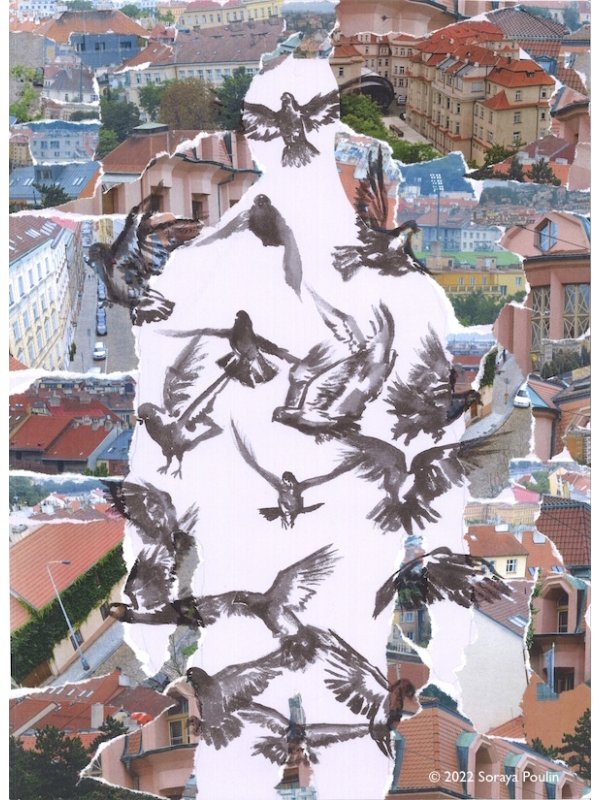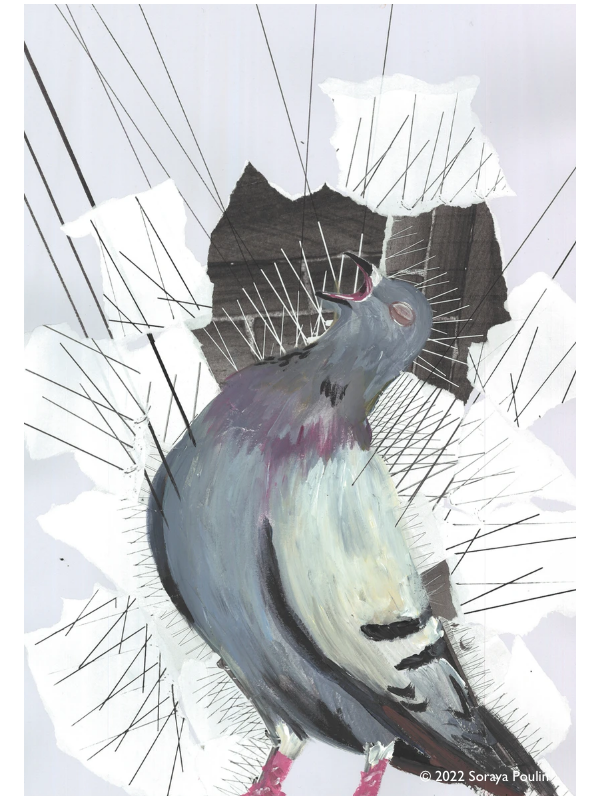Urban Bird
Non-human-centered visualisations of human-nature relationships in the city
by Soraya Poulin
I have always been interested in exploring the emotional links woven between people and their environment -observing how people interact with the nature, and translating these insights into my artworks. Collaborating with Mistra-EC researchers at Charles University during my residency in Prague has been an opportunity to build on, and refine, this interest, by focusing on the urban environment, and looking at the dynamics of relationships between humans and nature in the city: nature being represented, in this case, by the animals that inhabit our cities, especially the birds.
During my residency, I have tried as much as possible to come into contact with these animal inhabitants of the city: not necessarily physical, but rather emotional and spiritual contact. While I am aware that I cannot think in the place of a bird, by giving attention to them, and observing them, I have noticed the different patterns and timings within their respective species, and their different characters.
Birds in urban settings have adapted so well to human constructions that they occupy public squares, parks, monuments and buildings like tourists, and wander the streets like little city dwellers. Still, they remain discriminated against, with many children running after or trying to attack them, and many downtown window sills studded with birdproof nails. It would be interesting to put ourselves in their place, and consider what they think about us: the hostile and invading animal of this environment, perhaps? While animals adapt to new human constructions, humans are constantly trying to eliminate the smallest ounce of nature that tries to emancipate itself from it. The “weeds" are burned, the cellars deratized, and the rodents and birds hunted…
 |
 |
 |
|---|
Collages from "Urban Bird" project. © 2022 Soraya Poulin. All Rights Reserved.
However, this reflection only reinforces the separation created by society between human and a potential "nature" (of the flora and all the non-human animals), echoing the struggles between anthropocentric and ecocentric discourses about the environment. The inability of non-human living beings to produce a discourse further contributes to the dualistic way of approaching human-nature relationships.
But where, really, is the border between us: human and nature?
I was amazed when I discovered that most non-European cultures do not have an equivalent of the word "animal" or "plant" as a qualifier that defines a set of life forms. As with the language, what if this separation, these boundaries between human and nature began to intertwine organically, to merge until the two were no longer distinguishable from each other?
Here is where an arts-based research project comes in. While words have only defined and precise meanings, like constructions whose angles are right and the perimeter defined by a clear line, a visual creation makes it possible to question various abstract concepts and no longer simply represent facts. It makes it possible to question the balance of power in connection with these issues, not by taking a defined position, neither black nor white, but by seeking to represent the infinity of nuances that exist in the color spectrum, and therefore the different ways of seeing these subjects. This process consists of a search for various modes of communication to transmit academic knowledge, and address practices and social structures that (re)produce environmental problems, that may help us to ultimately transform into a more sustainable society.
My residency project, Urban Bird is part of the desire to question our place within this ecosystem that is the city, by visualising and expressing different, non-human-centered views on human-nature relationships, and turning one's attention to the immediate surroundings and the biodiversity that exists amidst buildings.
Soraya Poulin is a graphic designer and illustrator based in Switzerland. During the AiR@CU residency, hosted by the Mistra-EC research programme at the Institute of Communication Studies and Journalism at Charles University, she has worked on the emotional relationship of humans with their environment and the place they take within it, through the mediums of painting, photography and drawing.
Click to read more about Soraya’s residency project “Urban Bird”